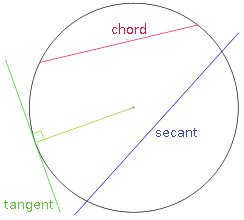We are going to study the relative positions where a straight line and a circumference can be in the same plane.
To do so, we will name several points, straight lines and segments that are singular in the circumference:
- Center is an interior point equidistant from all the points of the circumference.
- Radius is the distance from the center to any point of the circumference.
- Chord is the segment that joins two points of the circumference; the chords of maximum length are the diameters.
- Secant straight line is any line that cuts the circumference in two points.
- Tangent straight line is any line that touches the circumference at only one point.
- Touching point is the point where the tangent touches the circumference.

To find the common points of a circumference and a straight line we will solve the system formed by their equations. Namely if we have:
- the circumference given by the equation
- the straight line given by the general equation of a straight line:
What we must solve is one of two following systems (depending on the circumference given to us):
Note that once we know one of the two equations that define a circumference we can obtain the other one. Thus, we can consider the case:
which is an equation of the second grade in the variable
Since we have a general equation of the second degree, we know that depending on the sign of the discriminant (
- If
- If
- If
The different possibilities can be seen in the following picture:



